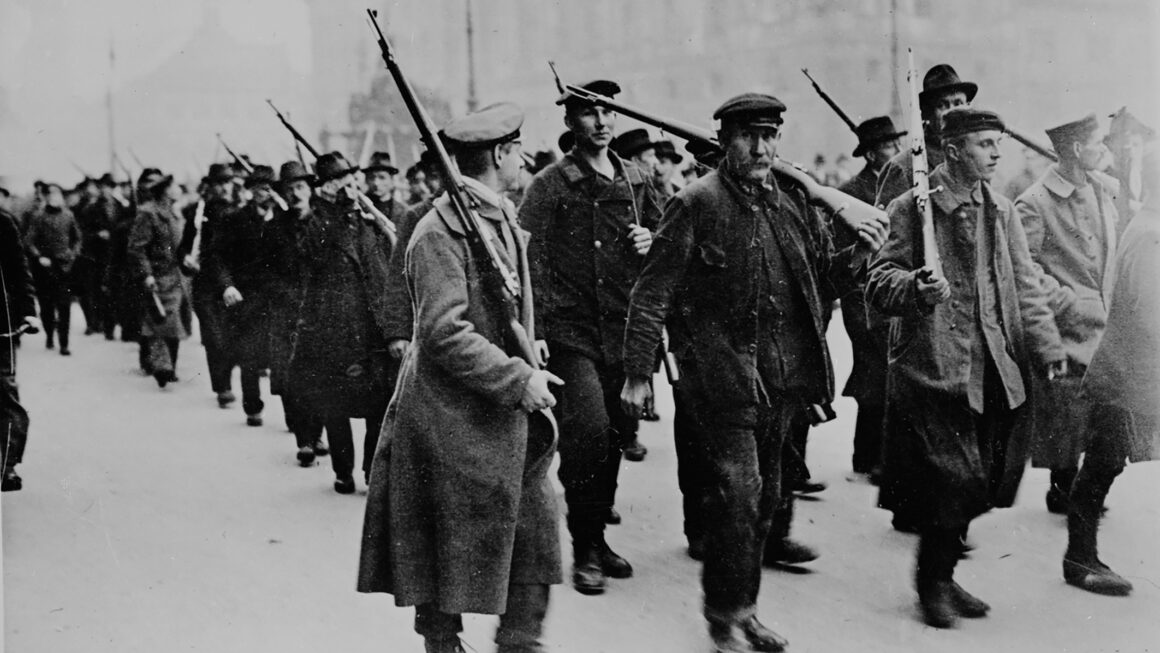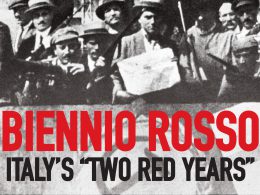By Robert Cosgrave
One hundred years ago Germany faced one of the deepest crises ever experienced in the advanced industrial world. The future of capitalist rule in Germany was seriously in doubt. The working-class movement, and the Communist Party of Germany (KPD) in particular, was presented with the opportunity to take power and follow the example of the Russian Revolution five years earlier. Had it succeeded it would have eclipsed the revolution in Russia, and greatly advanced the world revolution.
Tragically, the failure of the KPD and Communist International (Cominetrn) to provide the leadership needed marked the end of the global revolutionary wave that grew out of the Russian Revolution, and ultimately paved the way for the victories of Stalinism and Nazism in the following decade.
A century on from the defeat of this potentially world-changing moment, understanding the mistakes and drawing the necessary lessons remains essential for socialists as we face the prospect of major social crises and revolutionary events in our own time.
The crisis facing German capitalism
In November 1918, with German imperialism facing defeat in the First World War, an uprising of workers and rank and file soldiers overthrew the centuries-old Hohezollern monarchy, ending the war. The Social Democratic Party (SPD), once a Marxist party whose founders worked alongside Marx and Engels, had betrayed elementary socialist principles by supporting the aims of German imperialism during the war, and in the November Revolution it acted as the decisive defender of the German capitalist order. The traditions of the SPD and the absence of an alternative working-class organisation and leadership, however, meant that in 1918 it maintained the support of the majority of German workers.
The Communist Party (KPD) was only formed in the midst of the November Revolution, which meant that despite the presence of exemplary working-class leaders like Rosa Luxemburg and Karl Liebknect, who were the unparalleled leaders of the revolutionary wing of the German workers’ movement, it lacked deep roots in the working class, which limited its ability to effectively challenge the SPD in 1918-1919. In the early months of 1919, tens of thousands of workers would try to finish the work of November – of making the new republic a socialist republic – with workers’ and soldiers’ councils, similar to the ‘soviets’ of the Russian Revolution, being declared across the country. The response of the SPD government was vicious, enlisting the proto-fascist Freikorps to crush the workers’ revolt. Much of the original leadership of the KPD, as well as tens of thousands of ordinary workers, were murdered by the state.
Despite these devastating setbacks, new crises would provide new opportunities to challenge the SPD government and the weak capitalist republic it presided over. The Kapp Putsch in March 1920, an attempted coup against the government by right-wing nationalists, was stopped in a few days by a general strike of 12 million workers – many with arms in hand. The opportunity again existed for workers’ power in Germany, however the authority of the SPD had still not been sufficiently challenged by the KPD at this point and it was able to divert the energy of the struggle despite significant holdouts such as the Ruhr Red Army.
In October 1920 the KPD merged with the left-wing of the Independent Social Democratic Party (USPD), a centrist split from the SPD, making the KPD a real mass party. And even despite significant setbacks such as the adventurist ‘March Action’ in 1921 – based on the disastrous ‘theory of the offensive’ which argued that initiatives by revolutionary organisations themselves could be enough to spark real revolutionary events – the KPD now had the potential to offer a credible working-class and revolutionary alternative to the pro-capitalist policies of the SPD.
This was particularly dangerous for the capitalist class, as Germany was facing a severe economic crisis at this time. The victorious powers in the war – France in particular – imposed a harsh policy of reparations payments on Germany. The German capitalists didn’t want to see these payments eat into their profits so attempted to offset them onto the working class. The hope was that inflation would undermine the real wages of German workers and allow for the abolition of the eight-hour day, which they had only accepted because they feared it would be suicide not to. This was a plan the German workers would not take sitting down.
The invasion of the Ruhr
With the German government defaulting on its reparation debts, on 11 January 1923 the French and Belgian governments sent their armies in to occupy the Ruhr area – the centre of heavy industry in Germany – under the guise of guaranteeing the reparations payments. French capitalism was particularly interested in controlling the strong coal and steel industries of the Ruhr to prop up its interests and solidify its status as the dominant capitalist power in mainland Europe. In response to the occupation of the Ruhr, the German government – with the support of every major party barring the KPD – began the policy of ‘passive resistance’ in the Ruhr. It cancelled reparations payments and called on the region’s population to oppose any collaboration with the French-Belgian occupation.
The German government, the Reichswehr (German military), and the far right would attempt to use the developments in the Ruhr to whip up a nationalist frenzy across all of Germany. Paramilitary groups of the nationalist right flocked to the Ruhr area where they worked openly in tandem with the generals of the Reichswehr, who had been given free rein by the government to deal with the occupation. A sabotage campaign was organised in the hope that the ensuing reprisals would drive more and more German people into their arms. Many of these paramilitary groups constituted a parallel army, with tens of thousands of members with much of the modern equipment of the Reichswehr. In Bavaria, the state government gave these groups semi-official protection, on top of the funding and arms they were receiving from the military, industrialists and the aristocracy.
Although the French would imprison and execute paramilitaries involved in sabotage, the greatest violence of both the occupation authorities and the German state was directed at working-class people attempting to survive in the face of the crisis. At different times both occupation forces and German police would take turns opening fire on working-class communities organising to distribute basic foodstuffs in their communities. The writer and activist Victor Serge, in Germany as a reporter for the Comintern at the time, referenced letters from German state officials requesting assistance from French generals in putting down workers’ struggle in the Ruhr. This general was asked to return a favour, and was reminded that “at the time of the Paris Commune the German command did its best to anticipate the needs of the French authorities as far as repression was concerned.”
A massive amount of money was printed by the German state to support passive resistance. This led to further spiralling of the inflation crisis. In April 1922, one US dollar was worth 1,000 German marks; within days of the invasion it was at 56,000 marks; by September 1923, 325 million marks! The wages of workers rapidly became worthless, coming nowhere near the rises in prices. In August 1923 wages were 87,000 times their 1914 level, prices however were 286,000 times the 1914 level.
The KPD and the fascist threat
From June onwards, as the situation with hyperinflation worsened almost by the hour, a strike wave developed across Germany. From those with long traditions of struggle like metalworkers, to agricultural labourers who had up to then been very difficult to organise, workers were moving into action – to survive the unprecedented crisis. Despite the escalation of workers’ struggle, the leaderships of both the KPD and the Comintern severely underestimated the revolutionary potential in the situation and lacked a clear political orientation and strategy.
An enlarged meeting of the Comintern Executive Committee (ECCI, the international leadership of the Comintern) met in June and the discussion on Germany was still fixated on the need for the KPD to prepare for a gradual development of the struggle. No doubt many were still reeling from the calamitous March Action, a failed uprising that cost the KPD tens of thousands of members. Karl Radek, the Russian ECCI member most closely involved with the work in Germany, spoke here at length about how the KPD must avoid the provocations of the German ruling class and avoid falling into a trap. August Thalheimer, a member of the KPD national leadership, wrote of the German ruling class being compelled by the occupation of the Ruhr to act in an ‘objectively revolutionary fashion’ in the struggle against French imperialism.
It was at this meeting that Radek would deliver the infamous ‘Schlageter speech’ – after Leo Schlageter, a member of the Freikorps executed by the French authorities in the Ruhr for sabotage. Realising that with the growth of fascism beyond paramilitary thugs it was no longer enough to deal with the fascists physically or militarily, there would need to be a political struggle against fascism. Radek hoped that the fascists, who were supported by the big capitalists, could be weakened if the KPD undertook agitation to expose the programme of the fascists to the ruined middle classes and workers who supported them, and in doing so could politically neutralise their base of support.
While it was necessary to utilise a variety of tactics to undermine the support for fascist ideas, serious mistakes were also made, including at times giving too much credence to the nationalist arguments, such as the idea that Germany was being ‘colonised’ by France. As well as complicating the situation in Germany, this was a hindrance to the work of the Communist Party of France (PCF), which was working to build working-class solidarity between French and German workers.
Radek – who himself was nearly killed by the Freikorps in 1919 – can be accused of getting carried away in his speech about the potential to win “hundreds of Schlageters” away from fascism in the first place. Polemics with ‘National-Bolshevik’ pseudo-intellectuals or debates in universities with far-right student groups were not the means by which a political struggle against fascist ideas in society was going to be carried out.
Some of the KPD Left opposed the approach. Max Hesse objected to the publication in Die Rote Fahne (the KPD’s national daily paper) of material by nationalist writers for polemical purposes. Werner Scholem, another Leftist, was similarly critical of any potential accommodation to nationalism, criticising the approach of the KPD for insufficient anti-fascist work in May and declaring that “an intensified struggle against the fascists and for wages must be conducted outside the Ruhr… The political line of Die Rote Fahne was incorrect.” This group was not however a politically consistent or cohesive bloc. Also on the Left was Ruth Fischer, herself from a Jewish background, who in a debate with far-right students very crudely said:
“Anyone who rails against Jewish capital, gentlemen, is already a class warrior whether he knows it or not. They are against Jewish capital and want to overcome the stock exchange dealers – rightly so. Stamp down on the Jewish capitalists, hang them from the lampposts, crush them. But gentlemen, how do you feel about the big capitalists like Stinnes and Klöckner?”
Tactical turnaround
The approach of the KPD changed in mid-July when Die Rote Fahne issued the call to make 29 July an ‘Anti-Fascist Day’ throughout Germany. This was a call for mass demonstrations on the street to take on the fascists, a project to which the KPD was able to win a broader layer of workers organised in the trade unions and even some local organisations of the SPD, which were equally disgusted by fascism. The Proletarian Hundreds, a type of workers’ defence militia, proved particularly successful in mobilising those outside the KPD membership. In the capitalist press and among the mainstream parties the call by the KPD was condemned as a prelude to civil war. The central government called on the state governments to ban the demonstrations, which they did – with the only exceptions being in Saxony and Thuringia, where the left-wing of the SPD was in control.
The banning of these demonstrations created a crisis for the KPD leadership. It was terrified of being drawn into a provocation by the state, and being brutally crushed. With the debate among the leadership showing no signs of resolution either way, an appeal was made to the leadership of the Comintern in Moscow for advice. The position of Radek and Stalin, as against Zinoviev and Bukharin, was that the KPD should back down fearing a trap. This position won the day in the ECCI. Following this advice the KPD retreated. Outside of Saxony, Thuringia, and Württemberg, where street demonstrations were not banned, they instead held indoor meetings. While both the street demonstrations and the indoor meetings saw very strong turnouts, it represented a significant climb down by the KPD, although Die Rote Fahne would instead congratulate themselves for not falling into the trap set by the government.
Within days of the KPD’s climbdown, the depths of the crisis would be clear. At the beginning of August there was a vote of confidence in the government. The survival of the government in the first vote of confidence on 10 August led to the outbreak that day of mass political strikes against the government in Berlin, which rapidly spread across the country – including at the state printing press, which was sorely needed to maintain the flow of the massive sums of money created by hyperinflation. Although the government would collapse the following day, the SPD and a coalition of the main capitalist parties were able to form another government.
The leadership of the KPD and the Comintern were forced to suddenly change tack as they realised that the pace of events in Germany was far ahead of their previous prognosis, and were compelled to try to make up for lost time.
Organising ‘the German October’
The KPD leadership and the leadership of the Left faction would meet with the leadership of the Comintern in Moscow in early September and discuss the planning of an insurrection in Germany. Within the Soviet Union (USSR) the mood of working-class people was being elevated as the prospect of a socialist Germany, and the end of their isolation brought about huge hopes for a revival of a revolutionary wave across Europe. Workers, youth and the soldiers of the Red Army would all offer their support to the coming ‘German October’ in mass meetings across the USSR.
From a situation only weeks beforehand where they were calling off actions to avoid being caught by the trap of the ruling class, the KPD leadership had done a full 180, almost concluding now that the success of the revolution was inevitable. But against the advice of Trotsky that they set a date for insurrection and concentrate their energies on it, the position of the KPD leadership, supported by Radek, was that the day of the insurrection could be decided at an indefinite later point; that it would be a necessary outgrowth of the developing revolutionary situation. This position was described as ‘fatalist’ by Trotsky who responded that:
“the Communist Party has absolutely no use for the great liberal law according to which revolutions happen but are never made and therefore cannot be fixed for a specific date. From a spectator’s standpoint this law is correct, but from the standpoint of the leader this is a platitude and a vulgarity.”
Back in Germany, the new government was determined to clamp down on the Factory Councils and the KPD. Communist papers were repeatedly seized and warrants issued for the arrest of prominent KPD members, tens of thousands of whom would go underground, which meant thousands of militant leaders being removed from their workplaces just as an insurrection was being prepared. Where in July Die Rote Fahne would say the KPD had no need for the methods of conspiracy, by early September members of the leadership sang a different tune, saying:
“Comrades, under no circumstances should we proclaim a general strike. The bourgeoisie would find out what we are planning and would destroy us before we start. On the contrary, let us soften down our spontaneous movements. Let us hold back our groups in the factories and the unemployed organisations so that the government will think that the danger is over. And then – after they are lulled into an illusion of complete safety – let us strike in one night, quickly and decisively”.
Trotsky afterwards would critique this view of insurrection, commenting that, “resorting to trickery in politics, all the more so in revolution, is always dangerous. You will most likely fail to dupe the enemy, but the masses who follow you may be duped instead.”
Miscalculations and tactical blunders
The repression against the KPD continued throughout September. At the same time the far right was openly plotting against the government. The Reichswehr had de facto control in Bavaria and used this as the base for the planned putsch against the central government. The government took no significant action against Bavaria but did have another useful pretext for further repression against the KPD and the working class. In preparation for the insurrection, the KPD joined ‘workers’ governments’ alongside the SPD in Saxony and Thuringia. It hoped these governments would arm the Proletarian Hundreds and form action committees to prepare the insurrection, which would begin in Saxony and Thuringia and then spread across Germany. In response to the entry of the KPD into these governments the Reichswehr would threaten the two states with martial law.
The left Social Democrats who led in Saxony at this point would oppose in words the threats of the Reichswehr, but concrete steps were not made to provide arms for the Proletarian Hundreds. The call was also made across Germany for a defence of ‘Red Saxony’. In Berlin, trade unionists voted to declare a general strike if the Reichswehr attempted to invade Saxony. The Reichswehr, supported by the central government, nonetheless continued its plans to remove the ‘workers’ governments’ in Saxony and Thuringia. The state police were in reality under the authority of the Reichswehr not the state governments to which they were ostensibly ‘loyal’. Reservists were called up by the Reichswehr and troops brought into Saxony from the rest of Germany, allegedly to protect against attacks from the fascists and nationalists in Bavaria.
A conference of the Factory Councils was called to take place in Chemnitz for 23 October. In the plan of the KPD this Conference would issue the call for a general strike throughout Germany in defence of ‘Red Saxony’, and this would lead to an insurrection and a nationwide workers’ government. At this decisive moment the left Social Democrats in Saxony, despite all their previous declarations of their commitment to defending ‘Red Saxony’ were unwilling to translate that into the necessary action, hoping in vain for a deal to be cut with the national government.
The KPD’s plan was entirely reliant on the left Social Democrats supporting their call for an insurrection, and with the fatal vacillation of the left Social Democrats, the conference ended without any decision on whether to call for insurrection, and the plans of the KPD had to be abandoned. The strategy of the ‘workers’ government’, intended to act as a step towards a workers’ state and socialist revolution, turned into its opposite. Within days of the calling off of the insurrection, the ‘workers’ governments’ of Saxony and Thuringia were overthrown by the Reichswehr anyway, and the KPD was outlawed nationally until well into 1924.
Wrongly assessing the defeat
In the aftermath of the defeat the Comintern leadership made no attempt to seriously study what mistakes had been made during the year. What was done instead was that the KPD leadership around Heinrich Brandler was scapegoated for all the mistakes. The KPD leadership was bureaucratically re-organised by the Comintern around the Left in Berlin, who wildly declared that despite the setback of October, the situation remained as revolutionary as ever. There was no appreciation from the new leadership of the significance of the defeat in October. They carried through the bureaucratisation of the KPD that the Comintern leadership under Zinoviev had misnamed “Bolshevisation”. This would be their own undoing as they would be replaced within a year by the faction around Ernst Thälmann as Zinoviev lost out to Stalin in the Comintern bureaucracy.
It would be under Thälmann’s leadership that the KPD would follow Stalin in the catastrophically ultra-left ‘third period’ strategy from 1928, under which the KPD rejected the need to build a united front of the workers’ movement against fascism, as they now characterised the SPD not as a reformist trend in the workers’ movement but as ‘social fascist’ trend. This criminal policy paved the way for Hitler and the Nazis coming to power and smashing the most powerful workers’ movement in Europe without a real fight.
Those KPD leaders out of favour with the new Stalinist leadership also failed to learn from 1923. A few years after the events, Thalheimer, the main ally of Brandler and chief theorist of his group, wrote a pamphlet attempting to exonerate themselves by denying that the situation in 1923 was revolutionary after all.
The paramount lessons of 1923
In contrast to these, a serious attempt to examine the mistakes and lessons of 1923 was undertaken by Trotsky and the Left Opposition in the USSR, who saw the defeat in 1923 as a crisis of leadership in the KPD which in turn reflected the political degeneration of the Comintern leadership. Trotsky argued for the central role of a revolutionary party in taking up the active leadership of a revolutionary struggle, in the way the Bolsheviks had in 1917. He continued the argument he had in 1923 about the need to avoid a fatalist view of revolutions as happening automatically and developed it further, making the point that the strength of a revolutionary movement may develop ‘automatically’ up to a certain point, but there is no spontaneous collapse of the ruling class and that a successful revolution fundamentally needs to be carried through. As he explained: “the strength of a revolutionary party increases only up to a certain moment, after which the process can turn into the very opposite. The hopes of the masses change into disillusionment as a result of the party’s passivity, while the enemy recovers from his panic and takes advantage of this disillusionment.”
The fatalist view of revolutionary events led to the panicked retreat of the ‘German October’ when presented with the concrete difficulties involved. This view is also what undermined the ability of the KPD leadership to understand the meaning of the defeat, by seeing the question of revolution as something that develops in this automatic way whereby the victory of a revolution is an organic outgrowth of the revolution itself. In this view, defeat in 1923 by virtue of not being successful means it was not a revolution at all. The question of whether to set a date for insurrection as opposed to letting it be improvised on the day was not for Trotsky a question of exclusively technical importance, it was linked to the vital question of the method of a revolutionary party, and whether such a party is capable of acting in an actively revolutionary way, and not just in words.
The KPD leadership, caught unaware in 1923, were unable to transform all aspects of the party’s work in such a way as to organise a successful socialist revolution, instead making political turns in a frenetic manner which confused more than clarified. To have carried out such a turn successfully would have been decisive in 1923, the hundreds of thousands of committed Communist workers of the KPD intervening in workplaces and communities, in every strike and street action, in factory councils and trade unions, would have fundamentally transformed the situation and constituted the framework of a successful socialist revolution. However that framework did not exist in a developed way and it is not the case that such a framework – what Marxists call the ‘cadre’ of a party – develops automatically out of working-class struggle. To be sure, its development is rooted in struggle but it has to be very consciously fought for and built up in non-revolutionary periods.
Of course the work in non-revolutionary periods, especially successful work, inevitably impacts on a revolutionary party too, in potentially dangerous ways. It is from the routine in these periods of relative calm that a fatalist view can develop, leading to a conservative inflexibility, particularly in the leadership of a party. This was even the case for the Bolsheviks in 1917. Bolshevik leaders made many mistakes, for example on the approach to the Provisional Government immediately after the February Revolution, and later on some of the leadership were opposed to organising the October insurrection itself. And had their position won the day, no doubt the same arguments would have been purported: that the situation in October 1917 wasn’t revolutionary after all!
What was different in Russia was that over the years of building the Bolsheviks beforehand there had been a struggle to build up a revolutionary leadership, personified mainly by Lenin, and a revolutionary cadre of members grounded in Marxist theory, and rooted in and intervening into working-class struggle. It was the combination of this leadership and cadre that meant that the vacillating approach of some Bolshevik leaders was able to be corrected within the party at the decisive moments. The paramount lesson from the whole period of revolutionary struggle that swept Europe after the Russian Revolution is the necessity of building such an organisation, with such a leadership, based on such a cadre. Without this there cannot be a successful socialist revolution.
Notes
1. Centrism to 1920s Marxists meant organisations caught between a commitment to revolutionary socialism in words and reformism in practice. The USPD, formed in 1917 following the expulsion of anti-war members of the SPD, included both revolutionary Marxists like Rosa Luxemburg and Clara Zetkin and reformists like Karl Kautsky, a situation which could not last indefinitely. The left- wing of the USPD grew from the disappointment with the leadership’s reformist practice and at their Conference in October 1920 voted to join the Comintern and merge with the KPD. The majority of the rump USPD that remained would rejoin the SPD in September 1922
2. In March 1921 the state government in Saxony, led by the SPD, sent troops into an industrial area of central Germany, a stronghold of the KPD and a centre of intense class struggle to “restore order”. Armed confrontations broke out between the troops and police and workers led by the KPD and KAPD (an ultra-left split from the KPD) in the region. The KPD made the call for a general strike nationally but was unable to mobilise support outside of central Germany, the isolated workers were thus defeated and severe repression meted out. The defeat was a disaster for the KPD with it losing nearly half of its membership in the aftermath and thousands of its members sacked in their jobs
3. In his book The German Revolution: 1917-1923, still a key work for anyone studying the period, the French Marxist historian Pierre Broué wrote: “It seems that from November 1921, the magnates of German industry decided that the general situation must deteriorate before it could improve: runaway inflation would wipe out the German debt, bring the state to its knees before them, exhaust the working people, and leave the great capitalists alone as masters of the situation.” Pierre Broué, 2006, The German Revolution: 1917-1923, Haymarket Books, p. 710.
4. For information on the Paris Commune, see: Harper Cleves, ‘Spurn the Dust to Win the Prize: 150 Years Since the Paris Commune’, www.socialistparty.ie
5. Victor Serge, 2011, Witness to the German Revolution, Haymarket Books, p. 47
6. Broué, 2006, p. 710
7. Mike Taber (ed), 2019, The Communist Movement at a Crossroads: Plenums of the Communist International’s Executive Committee, 1922-1923, Haymarket Books, p. 491, p. 506
8. Taber, 2019, p. 509
9. Broué, 2006, p. 730
10. Taber, 2019, p. 618
11. Ralf Hoffroge, Class against Class: the ‘Ultra-left’ Berlin Opposition, 1921-1923, in Hoffroge & LaPorte (eds) op. cit., p. 101
12. Ibid, p. 100
13. Ibid
14. Broué, 2006, p. 759
15. Leon Trotsky, 1923, ‘Can a Counter-Revolution or Revolution be Made on Schedule?’, www.marxists.org
16. Broué, 2006, p. 772
17. Leon Trotsky, 2017, Lessons of October, Chicago, Haymarket Books, p. 82
18. The exact meaning of the term ‘workers’ government’ was the subject of much debate within the Comintern. A useful overview of the debate is provided here by John Riddell: ‘The Comintern’s unknown decision on workers’ governments’, www.johnriddell.com
19. See for example Arkadi Maslow, 1924, The tasks of the German Communist Party: Prospects, Partial Aims, Revolutionary Unity from Below, www.revolutionsnewsstand.com
20. August Thalheimer, 1931, A Missed Opportunity? The German October Legend and the Real History of 1923, www.marxists.org
21. Lessons of October, 2017, p. 69
22. Ibid, pp. 70-71












